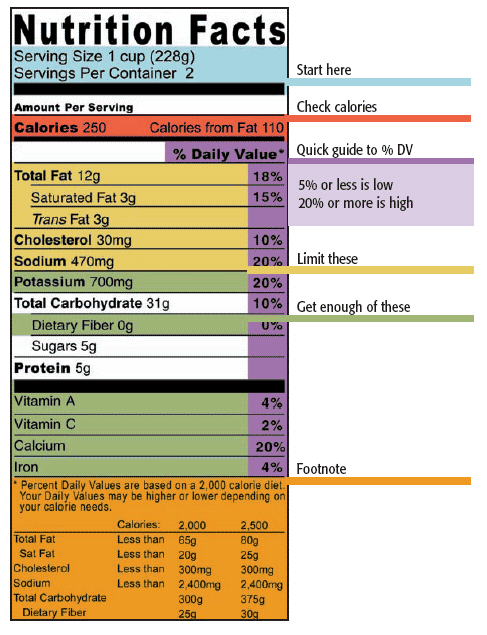Download PDF copy of this week's tip sheet
Watch this week's video tip below to see Gillian Goodfriend discuss how to get the most out of the information listed on your food labels.
Video Clip Text
When you look at the Nutrition Facts label, first check the serving size and the number of servings in the package. Many people often assume that the label gives the nutrition information for the entire food or drink item. In reality, the number of servings for a product can vary from 1 to 100! Pay attention to how many servings there are in a package and then ask yourself, 'How many servings am I consuming?'
 |
| Nutrition Facts |
What to Limit
The nutrients listed first (total fat, saturated fat, trans fat, cholesterol, and sodium), which are shown in yellow, are the ones you especially want to limit. Eating too much of these nutrients may increase your risk of certain chronic diseases, such as heart disease, some cancers, and high blood pressure. In addition, you want to monitor your intake of sugar, particularly added sugars in packaged foods such as cookies, cereals, and granola bars.
What to Increase
The nutrients shown near the bottom of the label (dietary fiber, protein, potassium, vitamin A, vitamin C, calcium, and iron) all generally play important roles in improving your health and helping reduce the risk of some diseases and conditions. For example, getting enough calcium helps improve bone strength and may reduce the risk of osteoporosis. Eating a diet high in dietary fiber promotes healthy bowel function. In addition, a diet rich in fruits, vegetables, and whole grains and low in saturated fat and cholesterol may reduce the risk of heart disease.
What Does the Bottom of the Food Label Mean?
First, the bottom of the label says, 'Percent Daily Values are based on a 2,000 calorie diet.' Therefore, the '% Daily Values' shown for each nutrient on the food label are simply estimates, based on consuming 2,000 calories per day. Although you may require more or less calories per day, depending on your needs, you can still use the % Daily Value as a frame of reference. It can help you determine if a serving of food is high or low in a certain nutrient.
The remaining information in the full footnote of the food label may not be on the package if the size of the label is too small. When the full footnote does appear, it will always be the same. It doesn't change from product to product because it shows recommended dietary advice for all Americans and is not specific to one food. Daily Values in the footnote are based on a 2,000- and 2,500-calorie diet. Note how the Daily Values for some nutrients (protein, fat, and fiber) change, while others (cholesterol and sodium) remain the same for both calorie amounts.
In addition, the ingredient list can be especially important because it can reveal hidden fats, added sugars, and types of grains and flours, in particular. The ingredient list provides the details that the 'Nutrition Facts' label may not show.
Please visit http://www.ncpad.org/survey/survey.php?sid=62 to provide us with your valuable feedback.
If you have any questions, please contact Gillian Goodfriend at ggoodfri@uic.edu or call 312-996-0907.
